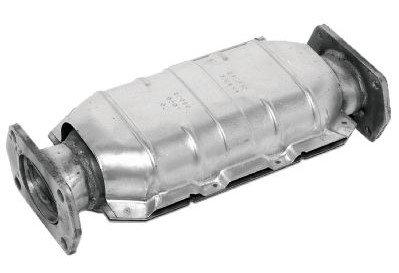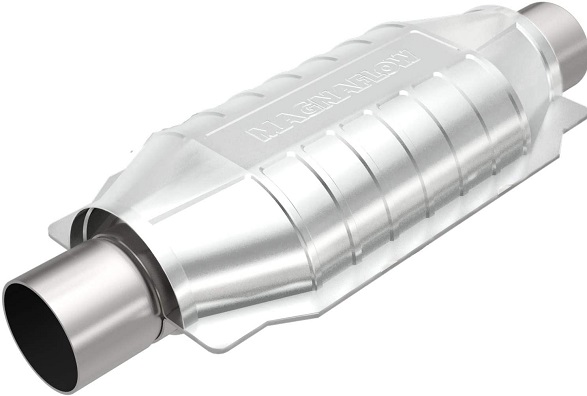Catalytic Converters (Function And Diagnosis)
Article by Mark Trotta
Mandated by federal U.S. law, catalytic converters have been fitted to American cars since 1975. Their sole function is to help reduce exhaust emissions. This is done by providing a place where enough heat can be generated that allows further combustion of hydrocarbons (HC) and carbon monoxide (CO).

How A Catalytic Converter Works
Exhaust gases flow through a substrate, which contain precious metals such as platinum and palladium. A chemical reaction occurs here. The exhaust gases increase in temperature as the conversion process takes place.
Because of the intense heat created by this process, exhaust gases leaving the converter should be hotter than the gases entering the converter. This is why heat-shields are used on most converters.
Pellet Type Converters
There are two major construction styles of catalytic converters. The pellet type is filled with alumina beads that are coated with either platinum or palladium, which are scarce and valuable elements used in jewelry, aircraft spark plugs, electrical contacts, and others. Today, their primary use is in catalytic converters.
The platinum or palladium are used as catalysts (palladium has similar chemical properties to platinum, but has a lower melting point and is less dense). As unburned hydrocarbons in the exhaust pass over them, they are chemically oxidized or converted to carbon dioxide and water.
Honeycomb Converters
Similar to the pellet type, the honeycomb (also called 'monolith') converter provides are larger catalyst area for the passing exhaust gases. They also use platinum or palladium as catalysts.
Two-Way Converters
Originally, converters were designed to convert only carbon monoxide (CO) and unburned hydrocarbons (HC). These early types were called "two-way" converters, and were used on U.S. cars between 1975 and the early 1980s.
Two-way converters operate relatively efficiently with a lean fuel mixture, but their ineffectiveness in controlling nitrous oxides (NOx) led to the introduction of three-way converters. Today, two-way converters are considered obsolete, and only fitted to lean-burn engines.
Three-Way Converters
Most present-day vehicles are fitted with a three-way converter, which in addition to converting carbon monoxide (CO) and unburned hydrocarbons (HC), also reduces nitrous oxides (NOx) into nitrogen and oxygen.

Three-way converters have been used in vehicle emissions control systems in North America (and other countries) since about 1981. This system utilizes one or more oxygen sensors to balance the fuel mixture between lean and rich conditions.
Three-Way-Plus Converters
The "three-way-plus" converter performs the same function as the three-way converter, but the difference is the addition of air between the two internal catalysts, which improves the oxidation of the converter.
Three-way converters, in conjunction with OBD-II diagnostic systems, will alert the driver when the converter is not working at peak efficiency.
Why Converters Fail
Several things will cause a catalytic converter to fail. An engine misfire, or an improper air/fuel ratio, can cause the converter to overheat.
If converter temperature exceeds 800 degrees, the precious metal catalyst wears rapidly. Higher than 1000 degrees, the catalyst in it's inner layer will sinter and die. Conversely, if converter temperature is too low after warm-up (between 475-750 degrees), no harm is done, but efficiency is sharply reduced.
The dirtier the exhaust, the harder your converter has to work, which produces more heat. In extreme cases, the converter can be seen to "glow" from excessive heat. If the converter works this hard to clean a dirty exhaust it will destroy itself.
Another cause of converter failure is oxygen sensor failure. Ensure the oxygen sensor is working properly to achieve the best air-fuel ratio.
A converter may also fail due to age and wear.
How Do I Know My Catalytic Converter Is Bad?
Symptoms of a bad catalytic converter include decreased engine power and hesitating or bucking when accelerating. An example would be feeling a loss of power when going uphill.
What are the Symptoms of a Bad Catalytic Converter?
Aside from not passing your state's emission's test, poor performance is a common sign of a bad or clogged cat. Other signs of a bad converter are, not being able to exceed 30-40 mph, and if there is a "rotten egg" smell coming from the exhaust pipe.
NOTE: Exhaust gas temperature (EGT) is important to the functioning of the catalytic converter of an internal combustion engine. It can be measured by an exhaust gas temperature gauge.
Check Engine Light Is On
Checking an engine code requires a OBD-II scan tool. An inexpensive hand-held version will work just fine.

What Does P0420 Code Mean?
The code P0420 signifies "catalyst system efficiency below threshold". Although many things can trigger a P0420 trouble code, the most frequent cause is a faulty catalytic converter. The converter may have worn out or degraded.
Other causes of the P0420 code include a bad oxygen sensor, damaged exhaust manifold or exhaust pipe, or leaking exhaust pipe. But the most common cause of a P0420 code is a faulty catalytic converter.
Aside from a scan tool, another way to test for a bad converter is with an infrared heat gun. With the motor fully warmed up, check the temperature of the converter. These tools are generally accurate from three to four feet away.
Servicing Catalytic Converters
Pellet style converters can be recharged with new coated beads, but most people just replace the whole unit. Replacing a converter is similar to that of a muffler, but there may be 02 sensors and/or air hose attachments on them that need to be taken off and then reattached.
Leaded vs Unleaded Fuel
Gasoline was originally unleaded. In 1919, lead was introduced to prevent unwanted pre-detonation (knocking). During the 1970's, the lead was taken back out to help vehicle emissions.
Modern automobile engines are designed to run on unleaded gas. Never use leaded gas in a catalytic converter equipped vehicle. The leaded fuel will put a coating on the platinum or palladium in the converter and negate their ability to function.

Sell Your Old Catalytic Converter
Your old converter is worth money, not only for the precious metals inside (platinum, palladium, and rhodium) but also the outer stainless steel shell. If you call a local scrap yard and ask for a quote, they will likely ask for numbers off the old converter, which are stamped into the housing. These numbers specify the year, make, and model it was from, as well as the converter's contents.
********************

Shop: Scan Tool

Shop: Infrared Temperature Gun
********************
Having an emissions-legal old car is a good way to show you care about the environment, as well as scoring higher in classic car show competitions.
********************
Related Articles: